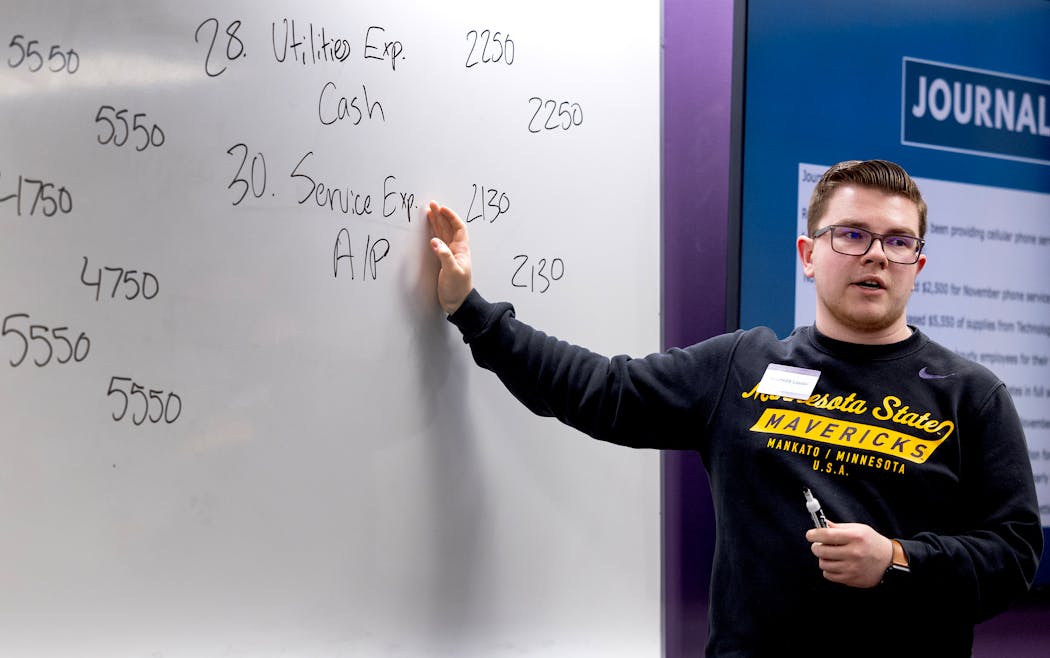MANKATO — The first anatomy exam of the semester was just days away when students gathered in the library at Minnesota State University, Mankato for a study session filled with games.
Want to mark your spot on a tic-tac-toe board? You need to name three types of protein in the cytoskeleton. Want to win at trivia? You need to know the cranial cavity houses the brain.
Overseeing the exam prep was Amal Sharafkhodjaeva, a junior who remembers vividly how hard it was to pass one of the university's toughest courses. Now she's working as a MavPASS leader, one of dozens of student employees running study sessions aimed at helping scholars thrive in the most difficult subjects and helping the university chip away at racial disparities.
"I think I passed the course just because of MavPASS," said Sharafkhodjaeva, who took the class last year. "The content is really hard to understand."
Minnesota frequently ranks among the states with the highest college completion rates, but glaring racial disparities persist. While roughly 60% of Asian and white adults in the state obtain a college degree, it's closer to 30% of Black and Hispanic adults, according to data from the Minnesota Office of Higher Education.
College leaders face increased pressure to reduce disparities in higher education in part because their pool of prospective applicants is becoming more diverse. By 2036, about 40% of Minnesota public high school graduates will be people of color, according to projections by the Midwestern Higher Education Compact, a nonprofit that works with colleges and universities.
So four years ago, Minnesota State Mankato began experimenting with a new program called MavPASS, short for Maverick Peer-facilitated Academic Support System. The university hires students who have passed some of the university's most difficult classes — chemistry, calculus and anthropology, among others — and asks them to run study sessions for students taking the courses now. Sometimes, they help students prepare for upcoming tests. Sometimes they review difficult new topics that were covered in a lecture or a lab.
"I loved the fact that it was peer facilitated," said Laura Jacobi, a communication professor and faculty liaison for the MavPASS program, noting students are sometimes intimidated by professors and feel more comfortable with peers. "Oftentimes, students don't want to show when they don't know something."
The university's data showed the program benefitted all types of students and narrowed racial achievement gaps. When students of color attended 10 or more MavPASS sessions, 94% of them continued on to the next semester; without those extra sessions, just 81% continued their studies. When white students attended those MavPASS sessions, 95% continued their studies, compared to 85% of those without the extra help.
Minnesota State Trustee Jim Grabowska said in a meeting earlier this month that the program represents a shift from an older "academic culture" that had a history of offering "wash-out classes, where they were intentionally designed or taught in order to separate those who get it from those who don't."
Student leaders understand tough topics
Students who have been through the program said it encourages them to get comfortable asking for help. Haley Nelson, a student who runs some of the study sessions for an accounting class, said she can see the change in students' confidence as the semester progresses.
MavPASS leaders undergo training to help them learn how to run study sessions and how to help students learn for themselves. Nelson frequently tells students, "Share what you think. Learn from it, even if it's not the correct answer."
Student leader Sam Christenson guided pupils in an introductory accounting course through a "big new concept" of balancing accounts and reconciling them in journals. A slide projected on a screen listed a series of transactions for a fictional communications company and students had to decide whether they should be listed as credits or debits and match them with the correct account.
When students ran into trouble, Christenson asked them, "So what is happening with the money?" and "What viewpoint are we coming from?" Students worked their way through the answers, one by one.
The MavPASS program has expanded over the years and now covers 25 courses.
In Sharafkhodjaeva's anatomy review session, she asked students to describe different types of glands that are found in the body and what function each serves.
What do sebaceous glands secrete? Sebum. Where can you find that? In the hair and the skin. And how did Sharafkhodjaeva tell the students she remembered that? Because some people's hair gets oily if they don't wash it for a few days.
Heading into the first exam of the semester, students are nervous, Sharafkhodjaeva said: "They are worried. They are trying to predict questions."
Sharafkhodjaeva tries to pass along some of the mnemonic devices and other tips that helped her pass the class.
"I know what my struggle was," she said. "I can understand."

From broken bones to a broken record: Unstoppable Swanson shines again

St. Paul officials acknowledge accessibility improvements needed at Como Zoo and Conservatory

St. Paul's Arborators play in the treetops: 'We're the world's only tree-climbing brass band'
Forest Lake High track athletes who were struck by car during a run expected to make full recovery



